Medieval castle
The motte-and-bailey castle first built on the spot seems to have been constructed very soon after the Norman Conquest, perhaps under order of Geoffrey Alselin who was granted the property in 1066, though more likely under order of Alselin's son-in-law, Robert de Caux, who used Laxton as his seat after Alselin's death. [2] The construction of the inner courtyard, or bailey, is common for smaller earthwork castles of Norman construction. [2]
The second wave of construction of the castle may have followed the appointment of de Caux to Hereditary Keeper of the Royal Forests of Nottingham and Derbyshire, although the extent of renovations undertaken by King John, who seized the castle for several years in 1204, is unknown. [2] In 1230, the property and title passed to the Everingham family, until they were stripped of the title in 1286; the property found insufficient to sustain the family further, they left it for other property in Yorkshire. [2] The castle subsequently fell into disrepair. [2]
The British Archaeological Association spotlighted the castle's defences, noting: [1]
The greatness of the outer court, the formidable character of the defences of the base court, the placement of the keep-mount on the edge of the steep natural escarpment on the northern side, and the evidence of the guarded track ways to the place, all tend to show the importance of Laxton Castle in the fighting days of its early existence, when feudal lords cared only for what they could get and hold, and had little thought for the rights of their neighbours.

Castle Rising is a ruined medieval fortification in the village of Castle Rising, Norfolk, England. It was built soon after 1138 by William d'Aubigny II, who had risen through the ranks of the Anglo-Norman nobility to become the Earl of Arundel. With his new wealth, he constructed Castle Rising and its surrounding deer park, a combination of fortress and palatial hunting lodge. It was inherited by William's descendants before passing into the hands of the de Montalt family in 1243. The Montalts later sold the castle to Queen Isabella, who lived there after her fall from power in 1330. Isabella extended the castle buildings and enjoyed a regal lifestyle, entertaining her son, Edward III, on several occasions. After her death, it was granted to Edward, the Black Prince, to form part of the Duchy of Cornwall.

Conisbrough Castle is a medieval fortification in Conisbrough, South Yorkshire, England. The castle was initially built in the 11th century by William de Warenne, the Earl of Surrey, after the Norman conquest of England in 1066. Hamelin Plantagenet, the illegitimate, parvenu brother of Henry II, acquired the property by marriage in the late 12th century. Hamelin and his son William rebuilt the castle in stone, including its prominent 28-metre (92 ft)-high keep. The castle remained in the family line into the 14th century, despite being seized several times by the Crown. The fortification was then given to Edmund of Langley, passing back into royal ownership in 1461.
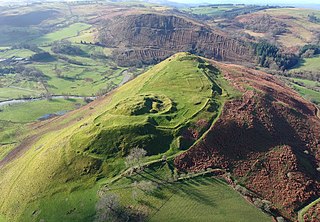
Cefnllys Castle was a medieval spur castle in Radnorshire, Wales. Two successive masonry castles were built on a ridge above the River Ithon known as Castle Bank in the thirteenth century, replacing a wooden motte-and-bailey castle constructed by the Normans nearby. Controlling several communication routes into the highlands of Mid Wales, the castles were strategically important within the Welsh Marches during the High Middle Ages. As the seat of the fiercely contested lordship and cantref of Maelienydd, Cefnllys became a source of friction between Llywelyn ap Gruffudd and Roger Mortimer in the prelude to Edward I's conquest of Wales (1277–1283). Cefnllys was also the site of a borough and medieval town.
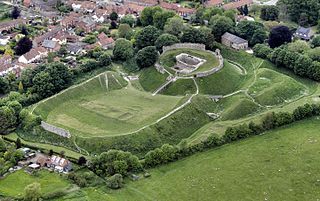
Castle Acre Castle and town walls are a set of ruined medieval defences built in the village of Castle Acre, Norfolk. The castle was built soon after the Norman Conquest by William de Warenne, the Earl of Surrey, at the intersection of the River Nar and the Peddars Way. William constructed a motte-and-bailey castle during the 1070s, protected by large earthwork ramparts, with a large country house in the centre of the motte. Soon after, a small community of Cluniac monks were given the castle's chapel in the outer bailey; under William, the second earl, the order was given land and estates to establish Castle Acre Priory alongside the castle. A deer park was created nearby for hunting.
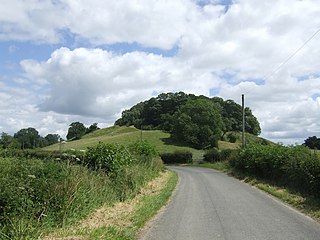
Caus Castle is a ruin of a hill fort and medieval castle in the civil parish of Westbury in the English county of Shropshire. It is situated up on the eastern foothills of the Long Mountain guarding the route from Shrewsbury, Shropshire to Montgomery, Powys, on the border between England and Wales. It was destroyed during the English Civil War and has been in ruins since.

Clare Castle is a high-mounted ruinous medieval castle in the parish and former manor of Clare in Suffolk, England, anciently the caput of a feudal barony. It was built shortly after the Norman Conquest of England in 1066 by Richard Fitz Gilbert, having high motte and bailey and later improved in stone. In the 14th century it was the seat of Elizabeth de Clare, one of the wealthiest women in England, who maintained a substantial household there. The castle passed into the hands of the Crown and by 1600 was disused. The ruins are an unusually tall earthen motte surmounted by tall remnants of a wall and of the round tower, with large grassland or near-rubble gaps on several of their sides. It was damaged by an alternate line of the Great Eastern Railway in 1867, the rails of which have been removed.

Laxton is a small village in the civil parish of Laxton and Moorhouse in the English county of Nottinghamshire, situated about 25 miles northeast of Nottingham city centre. In 1981 Laxton was sold to the Crown Estate, which is committed to maintaining the open field system. The population of the civil parish at the 2011 Census was 489.
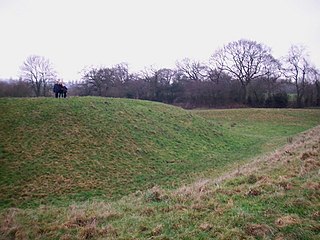
Shotwick Castle is a Norman medieval fortification near the village of Saughall, Cheshire, England. Construction began in the late 11th century. Its purpose was to control a crossing point on the River Dee between England and Wales. The site is a scheduled monument. No masonry features remain above ground except for earthworks.

Ashton Keynes Castle was a castle in the village of Ashton Keynes, near to the town of Cricklade in Wiltshire, England. It is also known as Hall's Close, while locals call it The Battlefield. The scheduled monument consists of a ringwork and bailey 100 metres (330 ft) west of Kentend Farm.
Bletchingley Castle is a ruined castle and set of earthworks partly occupied by three buildings. The Scheduled Ancient Monument is directly beside the Greensand Way below it to the south in the village of Bletchingley in Surrey. The site's tower standing from c.1170 to 1264 had a panorama from one of the narrower parts of the Greensand Ridge, which runs from mid-Kent to south-west Surrey.

Deddington Castle is an extensive earthwork in the village of Deddington, Oxfordshire, all that remains of an 11th-century motte-and-bailey castle, with only the earth ramparts and mound now visible.
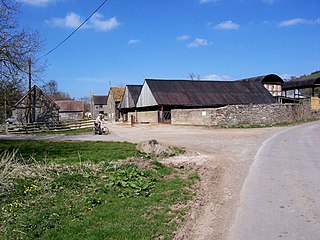
Bicton is a hamlet in southwest Shropshire, England, one mile north of Clun. The short River Unk passes through the hamlet. In previous centuries it was a township in the Clun division of the hundred of Clun.
Stockport Castle was a promontory castle in Stockport, Cheshire. The castle was in the medieval town, overlooking a ford over the River Mersey. It was first documented in 1173, but the next mention of it is in 1535 when it was in ruins. What remained of the castle was demolished in 1775.

Tickhill Castle was a castle in Tickhill, on the Nottingham/Yorkshire West Riding border, England and a prominent stronghold during the reign of King John.

Corfe Castle is a fortification standing above the village of the same name on the Isle of Purbeck peninsula in the English county of Dorset. Built by William the Conqueror, the castle dates to the 11th century and commands a gap in the Purbeck Hills on the route between Wareham and Swanage. The first phase was one of the earliest castles in England to be built at least partly using stone when the majority were built with earth and timber. Corfe Castle underwent major structural changes in the 12th and 13th centuries.
Geoffrey Alselin was an Anglo-Norman, who at some time after the Norman conquest of England received Elvaston, Derbyshire and Laxton, Nottinghamshire.

Tregrug Castle or Llangibby Castle is a ruin in Monmouthshire, Wales, located about 1 mile (1.5 km) to the north of the village of Llangybi, close to the settlement of Tregrug.

Moorhouse or Laxton Moorhouse is a hamlet within the Laxton and Moorhouse parish, in the Newark and Sherwood district of central Nottinghamshire, England.

Snodhill Castle is a ruined motte-and-bailey castle, about 1 mi (1.6 km) south of the village of Dorstone, west Herefordshire, England. It is now recognised as one of the major castles of the Welsh Marches, being built in the 11th century to secure the border between Norman England and the Welsh Princes. Archaeological excavations have found that it was one of the first Norman castles in the country to receive stone defences, with more sophisticated defences being added in later centuries. The castle was first mentioned in 1142. Although it was recorded as being in decay in the mid-16th century, it was probably was still in use in the 17th century. It remained in private hands until 2016, when it was acquired by a charitable trust to preserve the remaining structure.
















